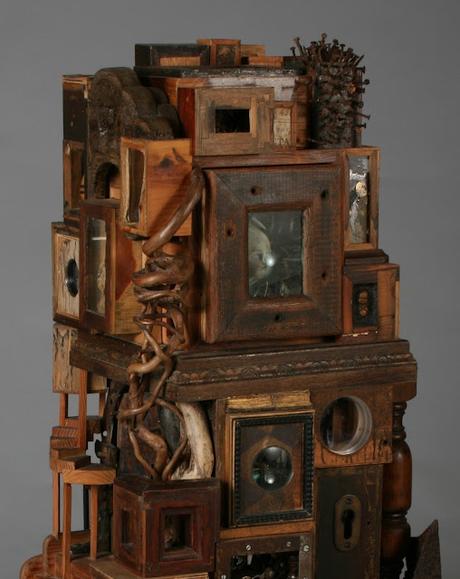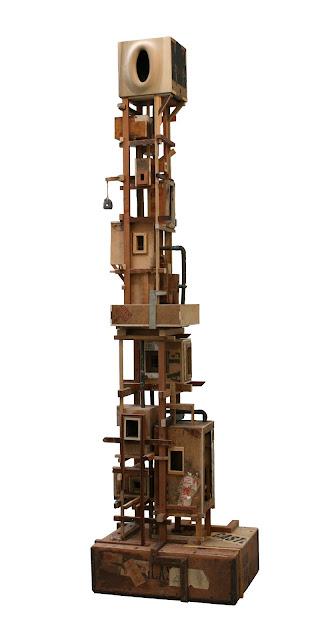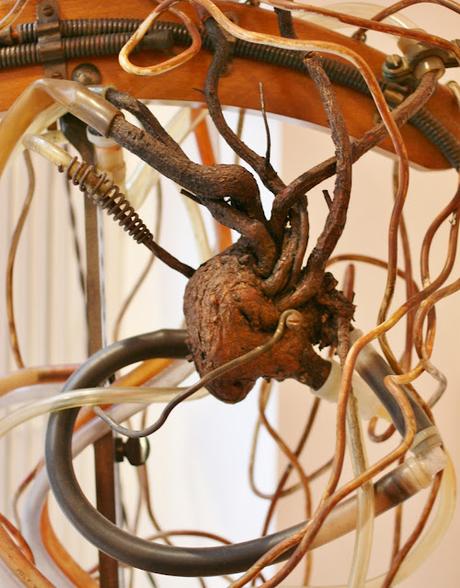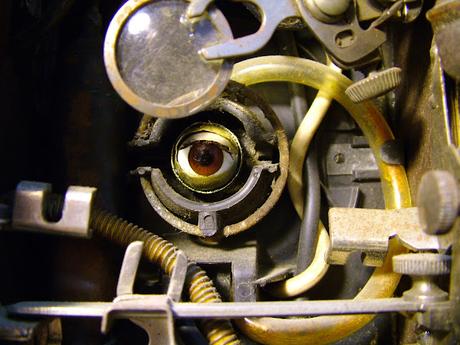As far back as I can remember, the natural world has always filled me with a sense of wonder. Rembrandt knew what he was talking about when he said "Choose only one master - nature". You can always tell when an artist, who draws plant or animal life, has really studied their subject closely. They come to some level of understanding, if only on a visual level, of the mechanisms of nature. I feel that drawing is as much the art of seeing as it is that of rendering.

Detail of 'The City' sculpture, 1999, by artist Wayne Chisnall
Ivy vines, especially the thick and gnarly ones that envelop massive trees, have always been a particular fascination of mine. When I was young I used to incorporate them in my paintings and even today I frequently use vines in my sculptures. I love the innate purposefulness evident in the plant's form; how its biological drives govern the way it grows, with the fascinating irregularities and meandering pathways of its branches. Even when I'm creating sculptures that aren't designed to represent biological organisms per se, I often try to create a sense of the organic in the visual flow of the piece. Although my tower and box sculptures are predominantly made up of lots of straight lines and right angles, I try to construct them in an organic manner, with an eye towards a naturalistic sense of balance or proportion.

'Orifice Tower' sculpture, 2012, by artist Wayne Chisnall
I'm writing about all of this because of what was going through my head after waking from a dream that I had a few mornings ago. The dream related to a job I had in the late 80s and early 90s, where I was employed as a technical illustrator for a Japanese company called Ricoh. In this job I used to illustrate the assembly/instruction manuals that the factory workers used to build the photocopiers that the company manufactured. This was back when all the illustrations were drawn by hand - ink pen on paper. Unfortunately I no-longer have any examples of the illustrations that I produced way back then, which is why all the photos I've included in this post more closely relate to the use of vines and other organic materials, that I mention incorporating in my sculptural work.
In the aforementioned dream I was in a large white room and scattered on the floor and pinned up on the walls were blown up copies of my original illustrations. All the ones that caught my dream eye were of masses of wires and cables that were clumped together with cable ties. The reason that they stood out to me was that individually they resembled fibrous mounds, and jumbled together the sheets of paper collectively looked almost like a landscape. I was reminded of natural formations - particularly of the sort of hills that one might see in old Japanese or Chinese prints and watercolours.

Detail of 'Pharos Cyclops #1' sculpture, 28, by artist Wayne Chisnall
For many years I had tried to draw a line in the sand between my early life as a technical and magazine illustrator, and my later carer as fine artist. Even though many of my favorite artists are cartoonists and illustrators, I think that when I first went to art college, where I studied Fine Art, I naively felt the need to try and put that earlier aspect of my work behind me. Fortunately it was always there somewhere. The drawing precision that I gained from four years of technical illustration at Ricoh has always stuck with me (unless I'm particularly tired or distracted) - even emerging when I use my fast, scribbly drawing style. Even so, it wasn't until I had this dream that any connection (discounting the honed draughtsmanship skills) between my former technical illustrator life and my current fine art life was brought home to me. For the first time I properly noticed the similarity between the biological structures that so fascinate me, and the internal component arrangements of the machines that I'd been drawing all those years ago - the connecting factor being that their structural formations are governed by functionality. Admittedly the outer casings of human-manufactured machines also have a functional concern but aesthetics plays a large part in a product's outer appearance. That's not to say that the aesthetic wouldn't have a biomorphic slant - we are, ourselves, part of nature after all, so our sense of what is beautiful or pleasing will be informed by the environment we evolved in. What I'm particularly interested in, with internal machine components (in areas of the machine where it is not intended that users of the machine will ever look, so no concession to aesthetics is required), are instances of unintentional biomorphism that emerge for purely practical reasons, as they do in the none decorative side of the natural world.

Detail of 'The City' sculpture, 1999, by artist Wayne Chisnall
Anyway, this gives me plenty of food for thought and another possible line of creative enquiry. Maybe I should see if I can get an artist's residency at an electronics manufacturing company.

